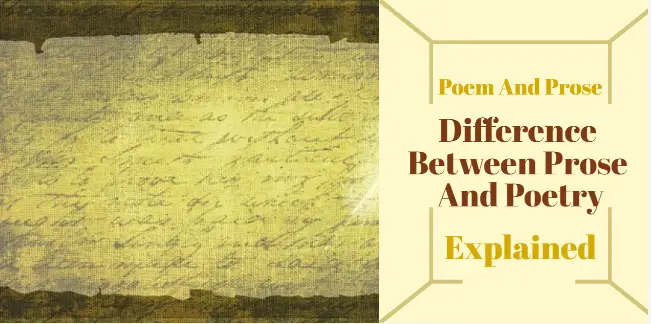Poem And Prose – Difference Between Prose And Poetry Explained

Written creative work in any language that possesses an enduring value in both aesthetics and application is referred to as literature. With its evolution, there are no hard and fast rules to define what it is, and has transcended the boundaries of space and time with the progress in the means of writing and its propagation.
In literature, two things are the key to how literature is represented to the reader – form, and content.
When it comes to the form of literature, there are two broad forms:
• Prose – a written work with no metrical structure. It depends on asymmetrical structures like sentences and paragraphs to achieve its form. There are many instruments that are common between these two forms, like repetition, alliteration, etc.
• Poem – this form is traditionally dependent on form and structure. The most common types of poetry are prose poetry, sonnets, haikus, etc. The emphasis in this form is more on rhyming and audible perception of the words.
There are many differences between these two forms and this is what we are going to discuss in this article.
From a bird’s eye view, prose depends on loose structures like sentences and paragraphs, whereas poetry has more tight structures like stanzas. The recent trends show that even poetry is diverging from its conventional course and has adapted forms like prose poetry. As the name suggests, this is very close to prose instead of poetry.
You will find prose in newspaper columns and features, online articles and blogs, short stories, etc. Poetry is something more aesthetically aligned with emphasis on meaning and the play of words.
Below, we will compare these two terms at length which will give a clearer picture of both.
Definition Of Prose
In a nutshell, the prose is a typical, ordinary style of writing. This deals with plots, structures, mood themes, points of view, settings, etc. in a variety of formats. This includes short stories, novels, novellas, articles, and many others. Even this article is a form of prose that is destined to convey information to the readers. This makes it a unique form of language. Grammatical sentences are arranged in a sequence that they become a part of one whole and in turn, sentences combine to form paragraphs. You will also find dialogues in it and maybe images to support the message, but this is not a universal practice. One thing is clear, there is no metrical structure in prose. This is a distinguishing feature that sets it apart from poetry.
This a great place for writers to write both fictional and non-fictional pieces. The techniques that are employed usually include heroic, alliterative, village, polyphonic, etc.
There is no limit to what prose can achieve with a variety of formats. Some of the most popular examples of this are:
• Fairy Tales
• Memoir
• Essay
• Short Stories
• Article
• Novel
And Many More!
Definition Of Poetry
Poetry is that format of literature that relies heavily on a complete imaginative feeling. A poet chooses appropriate language and selective vocabulary that are arranged in such a manner that comes out as a distinctive pattern in reading and reciting. There are two important concepts in poetry on which the foundation of poetry is built upon:
Rhyme – this deals with two or more words that have the same ending sounds. For instance, glass and class are two different words with different meanings, but they end with the same sound. A poet uses such words to evoke emotion and convey his thoughts forcefully and impressively to his readers and listeners.
Rhythm – this is created by combining a number of stressed and unstressed syllables in lines of a stanza for the desired effect. It is defined by the beat and pace of the poem and helps a lot in strengthening the ideas and message of a poem.
It is pure art, traditionally, that may or may not have any practical value to it. Usually, it uses an eccentric way to communicate something special with a reader, by choosing both stressed and unstressed syllables. Poets deal with a wide and diverse range of ideas and elements like moments, experiences, feelings, thoughts, etc.
The metrical structure of poetry sets it apart from prose that has no metrical structure at all. The main constituents of poetry are:
• Lines
• Couplets
• Strophe
• Stanza
There are many types of poems and the number of stanzas decides which type of poem it is. Stanzas are composed of verses or lines, that may or may not carry full thought or meaning outside the poem!
Comparison Of Prose & Poetry
Meaning
Prose – It is a straightforward, mostly no-nonsense form of literature. Most of the time, a writer expresses his views and opinions in a clear and lucid fashion. There was a time when it was said that what is written and does not rhyme is prose. There are many formats in this category such as novels, short stories, novella, articles, etc.
Poetry – this form deals with a unique, symmetrical style of expressing thoughts using different literary techniques. There is more room for the writer to either beat around the bush or come forcefully to the point. It was said that whatever that is written and rhymes in poetry.
Of course, it is not a rigid meaning but it gives you a clear image of what to expect.
Language
Prose – It is usually written in a straight forward vernacular. An author takes it to himself to explain the idea with a little gray area for the reader to explore.
Poetry – the language in this format is tuned to evoke emotions with decorative flowery phrases. Poets usually use techniques to make the readers draw more than one conclusion from poetry.
Read more about Poetry
